

Malin Franzén. Notice any similarities? Departmental transfers in the 19th and 20th centuries mean you can now find Hans Sloane's prints and drawings @britishlibrary and @britishmuseum. These were in MS 5220 until 1928. #collectionsunited. These Stunning Botanical Images Are Blueprints of the Past. It’s the summer of 1929.
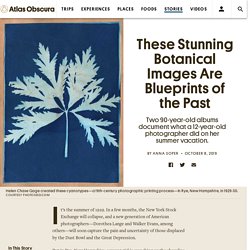
In a few months, the New York Stock Exchange will collapse, and a new generation of American photographers—Dorothea Lange and Walker Evans, among others—will soon capture the pain and uncertainty of those displaced by the Dust Bowl and the Great Depression. But in Rye, New Hampshire, a young girl is crouching on the shoreline, gathering flowers for a series of photographs inspired by some of the medium’s earliest explorers. She is working with photography at its most elemental—capturing sunlight on a sheet of paper washed with salts and fixed in water. Helen Chase Gage was born in Bronxville, New York, in 1917. She studied art history and fashion at Brooklyn’s Pratt Institute, and later worked as an executive at the Westchester branch of Lord & Taylor. Making a Wild Strawberry Sculpture from Honey Bee Wax. A Scientific Art Collaboration with Cornell University, New York.
Written by Annette Townsend, Natural History Artist, Designer, Maker, Cardiff. © Annette Townsend In November 2017 I attended the Cross-pollination, Revaluing Pollinators through Arts and Science Collaboration conference at Swansea College of Art.

The conference marked the end of a successful and pioneering project funded by both the Arts and Humanities Research Council (AHRC) and the Arts Council of Wales, combining Art with Science to explore new insight into perceptions of the value of honeybees and wild pollinators. As an artist I’ve spent most of my career working alongside scientists on science communication projects and my current work focuses on the protection of nature and features pollinating insects, so the project was of great interest to me. Scott’s NYS Beekeeper Tech Team at Cornell had been conducting research to promote best management practices to improve honey bee health and reduce colony losses.
The final sculpture took several weeks to complete. Unexpected prints and drawings? Hans Sloane’s 'A Roll more than 10 ft long by one in width, containing colored drawings or impressions of various sorts of #leaves of plants', Add MS 5026 (partially unrolled) Propagating Eden: Uses and Techniques of Nature Printing in Botany and Art - Arts at Wave Hill. With Propagating Eden: Techniques of Nature Printing in Botany and Art, the International Print Center New York (IPCNY) and Wave Hill pay homage to the beauty of natural plant forms, pure and unadulterated, captured by artists and botanists past and present.
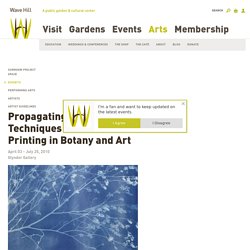
Nature printing is a name given to the technique of taking impressions from the surface of an organic form, such as a leaf, flower, feather, skin, shell, bone, or mineral. The process is suggested by nature herself, in fossil remains that reveal evidence of the origins of life and clues to the pathways of evolution. The human impetus to create self-prints can be as simple as a child’s finger painting, and as poignant and poetic an assertion of one’s presence in the world as the stenciled, silhouetted outlines of human hands found in prehistoric cave paintings—both gestures seeming to declare: “I was here.”
Exhibition Panel Discussion May 23, 2010 at Wave Hill House Download Catalogue (pdf) Art & Algae: The Work of Anna Atkins Polysiphonia Affinis from Anna Atkins’ Photographs of British Algae: Cyanotype Impressiona “To my dearest father this attempt is affectionately inscribed” reads a touching dedication in the frontispiece of a rare book.

The page is a cyanotype print of the most vibrant blue, and the lines of white hand-written words are those of early naturalist and photographer Anna Atkins. Several lifetimes older than myself, Photographs of British Algae: Cyanotype Impressions is thought to be the first book to feature photographic images. In 1841, William Harvey had published another first of its kind, A Manual of British Marine Algae. BIU Santé - L'herbier de Paolo Boccone. The nature-printed British sea-weeds: Henry Bradbury. Title The nature-printed British sea-weeds : a history, accompanied by figures and dissections of the Algae of the British Isles / By William Grosart Johnstone and Alexander Croall.
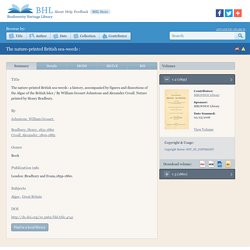
Nature printed by Henry Bradbury. Charles Darwin (1758-1778): Nature printing. This small volume of ‘nature printed’ leaves and flowers offers an intriguing insight into late eighteenth-century botany.
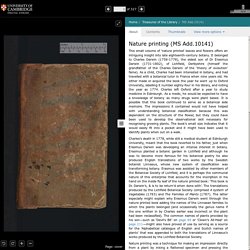
It belonged to Charles Darwin (1758-1778), the eldest son of Dr Erasmus Darwin (1731-1802), of Lichfield, Derbyshire (himself the grandfather of the Charles Darwin of the ‘theory of evolution’ fame). As a child, Charles had been interested in botany, and had travelled with a botanical tutor in France when nine years old. He either made or acquired the book the year he went up to Oxford University, labelling it number eighty-four in his library, and noting the year as 1774.
Charles left Oxford after a year to study medicine in Edinburgh. Isabella Gifford: The marine botanist. If you are generating a PDF of a journal article or book chapter, please provide title and author information.
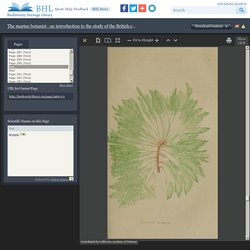
BHL stores this information to allow these articles to be indexed, searched and retrieved by other users. If you download an article but do not provide title or author information, these articles will be lost. Thank you for your request. Please wait for an email containing a link to download the PDF. For your reference, the confirmation number for this request is . Join Our Mailing List Sign up to receive the latest BHL news, content highlights, and promotions. Subscribe Help Support BHL. Johannes Kentmann 1549; with some nature prints. V.1 (1758) - D. Io. Hieron. Kniphofii pathol. et prax. in Acad. Erfurt. prof. publ. ordin. facult. med. senior. et adsess. primar., Acad. Caesar. nat. curiosor adiuncti, et bibliothecarii Botanica in originali, seu, Herbarium vivum :
Kniphof. Zenobe Pacini pharmacien. Title : [Plantes vivantes exprimées par le cylindre] : [estampe] / [fait à Florence par Zenobe Pacini pharmacien] Author : Pacini, Zenobe (14..-15..).

Graveur Publisher : (Florence) Publication date : 1520 Type : image image Type : still image still image Type : engraving engraving. Fabio Colonna nature prints. L'impression naturelle en botanique. Nature Printing: The Italian Art. 2013 Botany List Web. Wellcome Images. Lepidochromy: Butterfly Transfer Prints. This post was originally published on the Smithsonian Libraries' blog.

It was written by Daria Wingreen-Mason, Special Collections Technical Information Specialist in the Joseph F. Cullman 3rd Library of Natural History. Horace Waller was an English missionary and anti-slavery activist in the 19th century. In 1859 Waller joined the Universities’ Mission to Central Africa (UMCA). As Lay Superintendent to the UMCA, Waller befriended the famous missionary Dr. Waller was an amateur naturalist, but a clearly practiced one, who shared his collection with experienced naturalists such as Roland Trimen who later thanked Waller for showing him specimens from the Shire valley.
Lost nature printing technique subject of new book inspired by Chelsea Physic Garden. March 18, 2016 by ArtPlantae Nature-printed fern by Henry Bradbury © private collection The Chelsea Physic Garden has announced the the upcoming release of The Nature-Printer: a tale of industrial espionage, ferns and roofing lead by Simon Prett & Pia Östlund, a limited edition book about a lost technique of nature printing first announced in Vienna in the 1850s.

Plants that draw themselves.